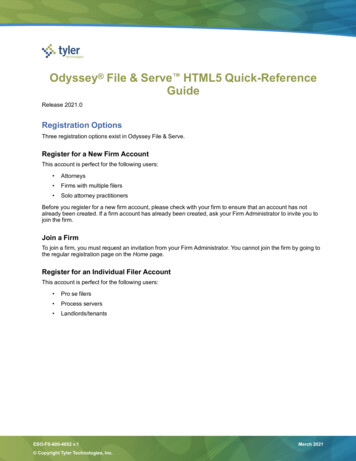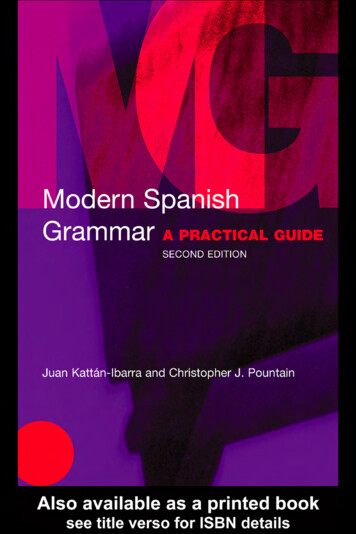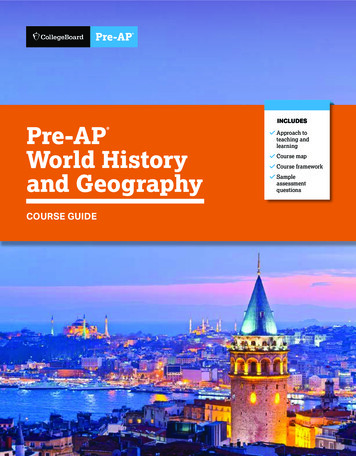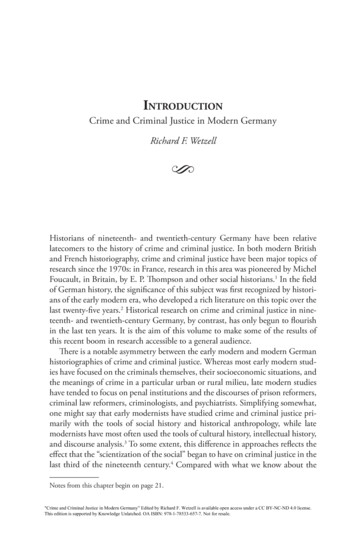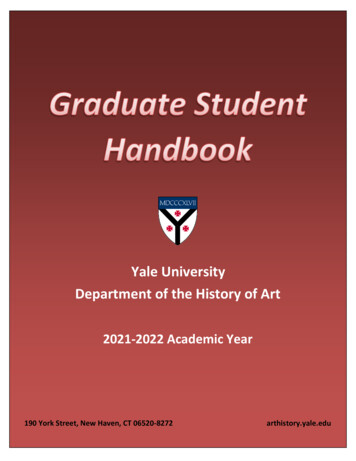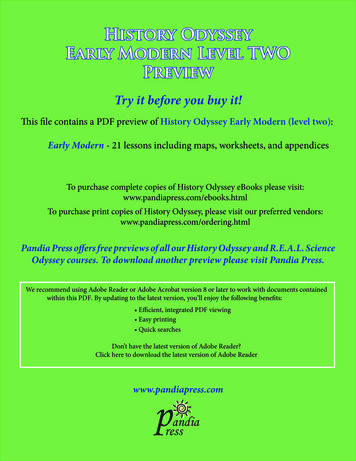
Transcription
History OdysseyEarly Modern Level TWOPreviewTry it before you buy it!This file contains a PDF preview of History Odyssey Early Modern (level two):Early Modern - 21 lessons including maps, worksheets, and appendicesTo purchase complete copies of History Odyssey eBooks please visit:www.pandiapress.com/ebooks.htmlTo purchase print copies of History Odyssey, please visit our preferred vendors:www.pandiapress.com/ordering.htmlPandia Press offers free previews of all our History Odyssey and R.E.A.L. ScienceOdyssey courses. To download another preview please visit Pandia Press.We recommend using Adobe Reader or Adobe Acrobat version 8 or later to work with documents containedwithin this PDF. By updating to the latest version, you’ll enjoy the following benefits: Efficient, integrated PDF viewing Easy printing Quick searchesDon’t have the latest version of Adobe Reader?Click here to download the latest version of Adobe Readerwww.pandiapress.compandiaress
HISTORY ODYSSEYEARLY MODERNPREVIEWA LITERATURE BASEDSTUDY GUIDE COMBININGHISTORYGEOGRAPHYWRITINGWRITTEN BYKATHLEEN DESMARAISLEVEL TWOHO-EarlyModern-II.indd 15/19/2007 2:51:04 PM
History OdysseyEarly Modernlevel twoPREVIEWTo purchase a complete copy of HO Early Modern (level two) eBook click the direct linkbelow :www.e-junkie.com/ecom/gb.php?i 130549&c cart&cl 17780To purchase a print copy of HO Early modern (level two) please visit one of our preferredvendors: www.pandiapress.com/ordering.htmlKathleen DesmaraisPandia PressBLANK PAGES HAVE BEEN REMOVED FROM THIS EBOOK FILE. YOU ARE NOTMISSING ANY PART OF THE COURSE, EVEN THOUGH YOU MIGHT NOTICESOME MISSING PAGE NUMBERS. ONLY BLANK PAGES HAVE BEEN REMOVED.
Dear Customer,Thank you for previewing this Pandia Press eBook. So that you can enjoy all the features of this eBook and use it formany years with your children, this eBook contains no printing and downloading restrictions. In order that Pandia Pressmay continue to provide eBooks without cumbersome restrictions, it is very important for customers to avoid any copyrightinfringements of our eBooks. Please do not share (email, download, print and distribute, resale, etc.) any portion of thiseBook to anyone outside your immediate family and for any use other than with your own children. Licensing is availablefor group, school, and co-op use. Please contact Pandia Press for details on licensing (ebooks@pandiapress.com). Thankyou for your cooperation. Legal use and downloads of eBooks will ensure that Pandia Press can continue to offer moreeBooks in the future.Thank you for your patronage and I hope you enjoy using your eBook.Kathleen DesmaraisPublisher, Pandia PressImportant information on web links:Web site links are provided to assist students in research. At the time of printing this guide, all web siteslisted were functional. Because web site content changes frequently, Pandia Press cannot guarantee theavailability of web links provided nor can we be responsible for internet viruses, inappropriate, inaccurate,or objectionable materials. We encourage parents and teachers to monitor and supervise students while onthe internet. We highly recommend the use of internet filtering software and recommend students avoid chatrooms, downloads, and giving personal information while on the internet.Copyright 2006 Pandia PressAll Rights ReservedWithout limiting the rights under copyright reserved above, no part of this publication may be reproduced,stored in or introduced into a retrieval system, or transmitted, in any form, nor by any means (electronic, mechanical, photocopying, printing, recording, or otherwise), without the prior written permission of Pandia Press.The purchaser of this study guide may photocopy maps and worksheets for use with her/his own children.Copying for group, co-op, classroom, or school use is prohibited. Contact Pandia Press for information aboutordering extra worksheets, maps, and about school licensing.Published byPandia PressWeirsdale, FLVisit www.pandiapress.com for sample pages of Pandia Press publications and for ordering information.
This guide is dedicated to Pete, Sarah, Chris, Charlie, and Gracie.A special thanks to the following people who made contributions, gentle criticisms, and test runs:Julie BlackwellRebecca ChatskisJacob DavisKristin DavisSarah DesmaraisMary GroeningerJessica GunbyMelanie MickaLora PendletonCatherine RoseberryJeannette StermerSandra WallaceHeather WilliamsSarah Williams
Table of ContentsLetter to Parents and Teachers . 5How to Use This Guide. 7Part I Trade and Rebellion . 11Lesson 1 Review of Europe and the Stuarts . 13Lesson 2 The English Civil War . 13Lesson 3 The Thirty Years’ War and Religious Warfare . 14Lesson 4 France . 14Lessons 5 - 6 Louis XIV, The Sun King . 15Lesson 7 I, Juan de Pareja . 15Lesson 8 Spain . 15Lesson 9 Spanish Succession . 16Lessons 10 17th Century Art and Architecture . 16Lessons 11 - 12 Scientific Revolution or the Age of Reason . 16Lessons 13 - 14 Evaluating Resources . 17Lesson 15 Galileo . 18Lesson 16 Early American Settlers . 18Lesson 17 The Landing of the Pilgrims . 18Lesson 18 The Mayflower Compact . 18Lesson 19 How to Write an Essay . 19Lesson 20 India . 19Lesson 21 East India Trading Companies . 19Lesson 22 Amos Fortune, Free Man . 20Lesson 23 - 24 African States . 20Lesson 25 Trade and Pirates . 20Lessons 26 - 27 Mercantilism and Trade . 21Lesson 28 Japan Isolates Itself from Trade .22Lesson 29 Trade and Opium in China .22Lesson 30 The Witch of Blackbird Pond . 23Lessons 31 - 32 Colonial America . 23Lesson 33 The Salem Witch Trials . 24Lesson 34 Russian Expansion . 24Lesson 35 Peter the Great . 24Lesson 36 Sweden . 25Lesson 37 The Great Northern War . 25Lesson 38 Trade and Rebellion Around the World . 25Part II Revolution . 27Lesson 39 What is a Revolution? . 29Lesson 40 The Agricultural Revolution . 29Lesson 41 - 44 The Industrial Revolution . 29Lesson 45 Scottish Rebellion . 31Lessons 46 - 48 Kidnapped . 31Lesson 49 Literary Element: Theme . 33Lesson 50 The Rise of Prussia and the Decline of Austria . 34Lessons 51 - 53 The Seven Years’ War and the Fight for North America. 34Lesson 54 The Enlightenment . 36
Lesson 55 Island of the Blue Dolphins . 36Lessons 56 - 57 Russia . 36Lesson 58 Johnny Tremain . 37Lesson 59 Thomas Paine . 37Lesson 60 Persuasive Writing Assignment . 37Lessons 61 - 65 The American Revolution . 37Lessons 66 - 67 Carry On, Mr. Bowditch - optional . 39Lesson 68 “The Way to Wealth” . 40Lesson 69 The Bill of Rights . 40Lessons 70 - 71 The End of Slavery? . 40Lessons 72 - 73 The French Revolution . 41Lesson 74 Make the Connection . 41Lesson 75 The Napoleonic Wars . 42Lesson 76 Napoleon - Hero or Zero? . 42Lesson 77 The Congress of Vienna . 43Lesson 78 Latin America’s Fight For Freedom . 43Lesson 79 Nationalism and Revolution in Europe . 43Lesson 80 Australia and New Zealand . 44Lessons 81 - 83 Growth of the United States . 44Lesson 84 Lewis and Clark . 45Lesson 85 Literary Element: Point of View . 46Lesson 86 The Sign of the Beaver . 47Lesson 87 Compare and Contrast Writing Assignment . 47Lesson 88 Revolution Around the World . 47Lesson 89 Timeline Analysis . 48Appendix A Attribution of Sources . 49Appendix B How to Write a Biography . 51Appendix C Guidelines For Evaluating Sources in History . 53Appendix D The Crime of Galileo, 1633 . 55Appendix E How to Write an Essay . 57Appendix F Firsthand Account of the Slave Trade . 61Appendix G Excerpts from A Journey from St. Petersburg to Moscow . 65Appendix H Excerpts from Common Sense by Thomas Paine . 67Appendix I The Boston Massacre . 73Appendix J “The Way to Wealth” by Benjamin Franklin . 79Appendix K The Bill of Rights, Amendments 1-10 of the United States Constitution . 83Appendix L Excerpts from the Age of Reason and the Enlightenment . 85Appendix M “The Two Grenadiers” . 89Appendix N Recommended Resources .91
Letter to Parents and TeachersYour child is about to embark on a great adventure—studying the history of mankind. History Odysseyguides are intended to assist your child on this adventure with access to the greatest resources and withassistance in organizing a tremendous amount of information. This guide is written for the logic- to rhetoricstage of a classical education (approximately sixth through tenth grade) and will challenge your child tocompare and contrast, analyze, research, write, and outline. This study guide expands upon the skills taughtin previous History Odyssey level two courses. Students who did not complete Ancients (level two) and MiddleAges (level two) should be able to successfully complete this course if they have some prior knowledge ofoutlining, research, and summarizing.This study guide contains many writing assignments including biographies and essays. Although basicinstructions are given, History Odyssey is not a writing course. We highly recommend that students completea formal writing class prior to or during this course. An Essay Rubric Checklist is included in the worksheetsection to assist you with evaluating your child’s essay work.The lesson plans in this study guide speak directly to your child for independent use. However, werecommend assisting with the first few lessons and acknowledge that some students may need assistancethroughout the course. Read over the following instruction pages with your child and assist him or her insetting up a binder and gathering resources. Most of the lessons are written to be completed in one to twosittings. The exceptions to this are the lessons that instruct students to read one of the twelve literature booksand those containing library research assignments. For these lessons, students should be given ample timeto complete the tasks before going on to the next lesson unless otherwise indicated. If your child’s interest issparked by a subject, refer to the resource list and allow him or her to spend extra time on that subject. Wesuggest students at this grade level spend about two hours studying history three to four days a week. At thatpace, this guide provides a one-year history course. Keep in mind that these lesson plans combine severalsubjects—history, reading, writing, and geography.Most of the literature books used in this study guide are at a level that logic stage students can readindependently. Some students may benefit from having the books read aloud. Students will not be interruptedwith comprehension questions or vocabulary work while reading the assigned literature. We feel thatinterrupting the reading of these wonderful books tends to make reading laborious and frustrating. However,you may want to suggest that your child read with a pencil in hand and circle difficult words to look up later.Also it is recommended that you have discussions with your child during the reading to ensure comprehension.Ideally, you will read the books as well.A new addition to History Odyssey is the reference to Web sites throughout this and future study guides. Itis not necessary to access Web sites in order to complete this course. All Web site references provide optionalresources for research. We highly recommend students not use the Web sites exclusively for their research. Intoday’s high-tech world, it is easy for students to engage in “lazy research” by depending solely on the Internetfor information. Although the Internet does contain valuable information, it also contains vast amounts ofinaccurate information and harmful materials (see our disclaimer about Web sites on the copyright page).Please guide and supervise your child in Internet research and encourage him to engage in plenty of “oldfashioned” library research as well.NotesLiterature: There is a lot of good historical fiction available for reading while studying this time period. If yourchild has already read one or more of the books in the required reading for this course, you could substitute asimilar book. See Appendix N for suggested books.5
Timeline Work: In this edition of History Odyssey, students will not be given timeline dates for copying ontotheir timelines. Students are expected to identify significant dates themselves. Some students may requireassistance at first in picking out the most important dates. Make sure that your child is not writing every dateencountered on his or her timeline.Essays: In this edition of level two History Odyssey your child will be asked to write formal essays. Prior towriting the first essay there is a short lesson, “How to Write an Essay.” This lesson presents a starting point toteaching your child essay writing. (Many students may require additional instruction from a writing course thataddresses essays and thesis writing. See Appendix N for recommended courses.) The lesson on essays includesinstruction in writing topic sentences. Topic sentences are similar to thesis statements, which are presentedin Level Three courses. This lesson recommends essays be five paragraphs in length comprised of three mainideas to support the topic sentence. Please use this as a guideline only. If the topic sentence created by yourchild requires only two main ideas, then by all means don’t require creation of another one just to fit the model.As your child becomes a more proficient writer, allow him or her to break away from this model and be morecreative with writing.Carry On, Mr. Bowditch: This book and the subsequent lesson and map work are optional because they willsignificantly increase the length of this course. If time is short, we recommend your child read this wonderfulbook another time.Lessons 14 and 76: These lessons require your child search through several newspaper articles. Please ensureaccess to several newspapers on the days of these lessons.Lessons 21 and 79: In these lessons we recommend your child gives a presentation using PowerPoint oranother presentation soft ware if available. For examples of history presentations given with PowerPoint visitwww.pppst.com/worldhistory.HTML.Lessons 24 and 27: These lessons involve your child looking at the horrors of the slave trade. He or she willbe reading a somewhat graphic description of life aboard a slave ship and examining the reasons why peoplebecame involved in enslaving other human beings. These exercises are not attempts to justify the slave trade—quite the contrary. Assist your child in these assignments. Encourage contemplation of these questions: Whydo good people sometimes do bad things? How does crowd mentality contribute? How did people involved inthe slave trade justify ignoring individual rights? Please ensure that your child understands the point of theseexercises. If you feel there is a chance that your child might not understand, it would be best that he skips theselessons.Lesson 46: In this lesson your child will be constructing a book jacket and will need craft supplies. Refer to thelesson for a supply list.Lesson 76: Prior to this lesson about Napoleon, you might want to rent the PBS mini-series Napoleon bydirector David Grubin (2000). This excellent biography is available on DVD from Netflix and Blockbuster.Use parental discretion with this video. It contains a few disturbing descriptions of war violence, and some ofNapoleon’s letters deserve a PG-13 rating.6
How to Use This GuideRequired ResourcesThe following resources are required to complete this course. Optional resources and book suggestions can befound in the Appendix N.*The Kingfisher History Encyclopedia (1999 edition or 2004 edition) - KFH*The Story of Mankind by Hendrik Van Loon (Free online at www.authorama.com/story-of-mankind-1.html) TSOM*Timeline from Pandia Press (or a homemade timeline)I, Juan de Pareja by Elizabeth Borton de TreviñoAmos Fortune: Free Man by Elizabeth YatesThe Landing of the Pilgrims by James DaughertyThe Witch of Blackbird Pond by Elizabeth George SpeareOliver Twist by Charles Dickens (abridged by Puffin Classics)**Kidnapped by Robert Louis StevensonIsland of the Blue Dolphins by Scott O’DellJohnny Tremain by Esther ForbesThe American Revolution by Bruce Bliven, Jr.Carry on, Mr. Bowditch by Jean Lee Latham (optional reading)The Captain’s Dog: My Journey with the Lewis and Clark Tribe by Roland SmithThe Sign of the Beaver by Elizabeth George Speare*These resources are used for all History Odyssey level two study guides.** This edition of Oliver Twist is abridged for length only and contains Dickens’ original words. Advancedreaders and those with more time might want to read the unabridged Oliver Twist.Other Supplies NeededThree-ring binder (2 is recommended)Six binder dividers with tabsLined paper or computer paperA three-hole punchA detailed atlas or world wall mapA ruler or straight edgeColored pencilsMarkers, paint pens, and/or paintBasic craft suppliesNewspapersCopies of the worksheets (see the worksheet section for the number of copies required)Internet access (optional)Computer presentation software such as PowerPoint, Keynote, or Corel Presentations (optional)Setting Up Your BinderDivide your binder into the following six sections:SummariesMen & WomenWars & ConflictsArt, Inventions, & ArchitectureMaps & WorksheetsTimeline7
Insert the study guide in the front of your binder. Label the dividers and insert lined paper into the first foursections. Three-hole punch your timeline* and place it along with the maps and worksheets in their appropriatesections.*Alternatively, you can display your timeline on a wall while you are working on it, and then place it in yourbinder when finished. See below for information on making your own timeline.Lesson AssignmentsThroughout these lessons you will be asked to summarize readings by finding central ideas and outlining. Youwill also mark dates on your timeline, color and label maps, and read from the list of resources. Try to do all ofthe assignments listed. When asked to add a person or event to your binder, title your entry and include someimportant information. Place the entry in the appropriate section of your binder. A short summary is one totwo sentences. A lengthy summary should be a complete paragraph consisting of at least five sentences. Whenyou are finished with this course you will have a binder that is full of information you have learned and workyou have completed. More importantly, you will have an education about early modern history to treasurealways.Map WorkGeography is an important part of history and you will be learning a great deal of early modern and modernday geography throughout this course. When working with a map, carefully color areas with colored pencils.Do not use markers as they will bleed through the paper and blot out labels and other markings. You can makethe land areas colorful by coloring each country or area a different pastel shade. When labeling, use a ruler tolightly make a pencil line. Print the name carefully on the line with a fine-point black pen and then erase thepencil line after your ink dries. Take your time to make the maps beautiful keepsake treasures of your timespent studying early modern history.OutliningIn this course, you will be creating three-level outlines from readings found in the Kingfisher HistoryEncyclopedia. Outlining is a very important skill to learn. If you learn this skill well it will help youtremendously when reading complicated writings, when preparing notes for oral presentations and researchpapers, and when taking notes in high school and college courses. Outlining will help you separate main ideasfrom details. It will help you break down information into the most important parts and organize them.TimelineYou will need a timeline to complete this course. Using a timeline will assist you in organizing information andseeing connections between events. At the end of this course, you will be completing an interesting exercisein which you analyze the data on your timeline. Timelines can be purchased or constructed. The ClassicalEducation Timeline is available from Pandia Press. To construct your own timeline you will need a piece ofbutcher paper about 2½ feet long. Draw a line across the paper a few inches from the top. Leaving a little spaceat the beginning of your line for earlier events, mark dates beginning at the year 1575. Continue marking datesin 25 year increments ending with the year 1875. Space your dates approximately 2 inches apart. Accordion-foldthe timeline, three-hole punch it, and place it in your binder.As you enter events on the timeline you can either draw lines from the information to the point they occurredon the timeline or you can enter a reference number on the timeline that refers to a corresponding entry on aseparate piece of paper. (See examples of these two methods on the next page.)8
Options for Recording Dates on a TimelineWrite dates directly on your timeline:Thirty Years’War begins#176English Civil War#177Write reference numbers on your timeline that refer to entries on separate paper:#176 In 1762 Rousseau (considered the Fatherof the French Revolution) wrote TheSocial Contract, in which he emphasizedthe rights of individuals.#177 –1763 - Pontiacs Rebellion. NativeAmericans resisted British settlements inthe United States. Pontiac, tribal leaderof the Ottawa, led a rebellion that killed200 British settlers. Pontiac eventuallysurrendered.9
Part ITr ade and Rebellion
Lesson 1 Review of Europe and the Stuarts On Map 1, “Europe,” use your atlas to label the following SpainSwedenLabel the following bodies of water:Atlantic OceanMediterranean SeaLabel the following cities (use a dot to label a city):LondonOxfordParisShade the area of Europe your favorite color. Read TSOM chapter 45. This chapter begins with a review of warfare in Europe and English history thatyou will remember from studying the Middle Ages. Read the first eight pages of this chapter carefully to reviewevents such as the Battle of Hastings and the Hundred Years’ War, and significant people such as William Dukeof Normandy, Harold of Wessex, Joan of Arc, Henry VII, Henry VIII, Philip II, Elizabeth, and the Tudors. Newmaterial begins
early modern level two history odyssey a literature based study guide combining history geography writing written by kathlee

